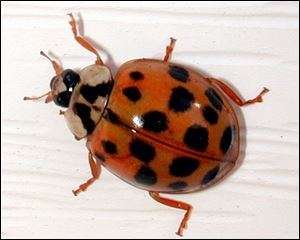
Simple steps keep pests outdoors
11/20/2002They're back! Have you noticed those pesky orange-and-black beetles dotting the inside of your windowpanes? You might find them in light globes, on tables, and even in your morning coffee. A space any more than 1/8-inch wide is plenty for the insects to enter a home.
They're multicolored Asian lady beetles (Harmonia axyridis). They resemble Ohio's state insect, the native convergent lady beetle (Hippodamia convergens), and they eat many of the same foods: Both lady beetles' larvae will eat damaging insects like aphids, scale insects, and other pests. Multicolored Asian lady beetles seek shelter indoors, and that sets them apart from native lady beetles, which stay outside.
Adult Asian lady beetles range in color from yellow to red. Some have spots, and some don't. Adults can live up to three years. They don't have stingers, so Asian lady beetles cannot sting, but they have been known to bite. When disturbed, they release a foul-smelling fluid. And if smashed, their blood can stain walls, drapery, or clothing.

Asian lady beetles range from orange to red. Some have spots, and some don't.
According to Ohio State University, Asian lady beetles were first released in the United States in 1916 to combat tree-feeding aphids and scale insects in California. They were released again in the 70s and 80s in Ohio and other states.
A few years ago, people started to complain that the insects were entering homes.
Lady beetles are attracted to light-colored surfaces because such surfaces are usually warm. You might find a swarm of Asian lady beetles on the south side of your house. They are probably trying to find a way to hibernate just under the siding, and will try to get inside.
Here are some pest-proofing steps recommended by Ohio State University:
If some lady beetles already have made it indoors, here are a couple of ways to get rid of them:
Pick them up by hand and dispose of them or suck them up with a vacuum cleaner. Be sure to empty your vacuum bag often. If that won't do, Ohio State University entomologists recommend using pesticides that contain pyrethroid Danitol. Read labels carefully and follow their directions for proper use.